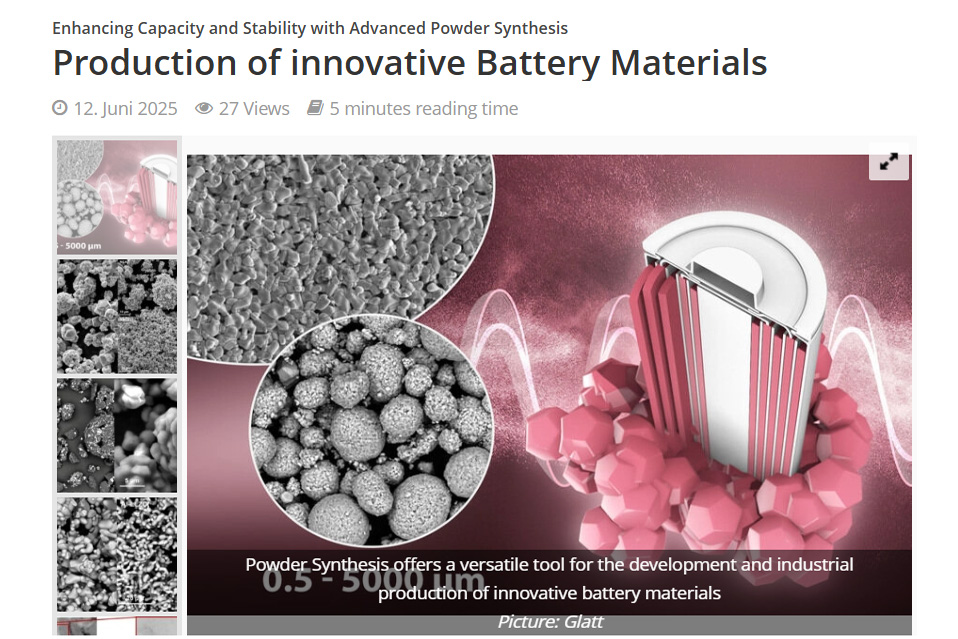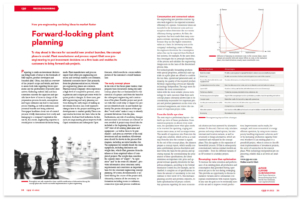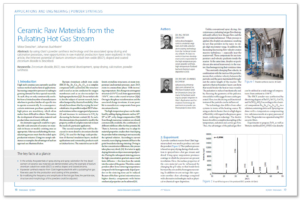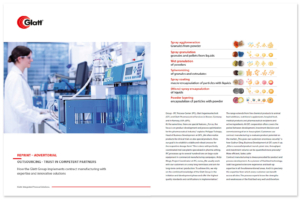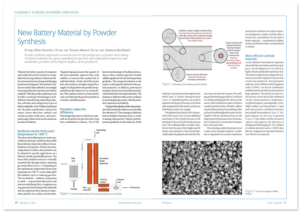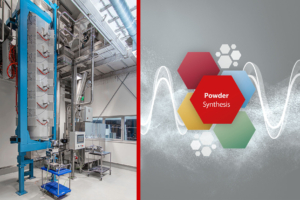Although the battery capacity of computers and mobile devices has reached acceptable levels of functionality and performance, there is still room for improvement in terms of charging speed and range, particularly in the field of electromobility. The search for solutions to overcome these issues is a strong driver of innovation. Glatt Powder Synthesis is a technology that is already being used in the production, activation and coating of new battery materials. The key to the effectiveness of this process is the use of a pulsating hot gas flow and application-specific conditions.
Developed by Glatt Ingenieurtechnik (Weimar, Germany) to synthesize a homogeneous powder, this technology first uses the raw materials to create a stoichiometric mixture, which is then dried and, if necessary, calcinated. Using this approach, even small quantities of doping elements can be homogeneously distributed into a prospective battery material to optimise performance characteristics such as capacity and charging behaviour.
Among other things, the durability and performance of active battery materials both depend on side reactions with the electrolyte. This, in turn, is a function of the applied voltage. With the increasing need for higher energy densities, it’s becoming more important to protect the surface of the anode and cathode.
For this purpose, Glatt Powder Synthesis can be used to coat these “active materials.” For core-shell particles, the dissolved coating material is sprayed in suspension together with the solid core material . This ensures that the coating material dries onto the core and, if necessary, calcinates. The process temperatures can be set from room temperature to 1300 °C, providing an almost infinite combination of coating and core material possibilities. Four specific application scenarios, listed below, demonstrate the range of Glatt Ingenieurtechnik’s technologies for modern battery materials.
Aerosol-based cathode material processing
The cathode accounts for the majority of the material costs of a battery cell. Cost-effective, highly efficient and durable components are therefore particularly important here (see, for example, Figure 1). Compounds currently used include lithium metal oxides (layered oxides such as NMC [LiNixMnyCozO2], NCA [LiNixCoyAlzO2] or spinel oxides such as LNMO [LiMn1.5Ni0.5O4]) and lithium metal phosphates, such as LFP (LiFePO4). Glatt Powder Synthesis is an ideal way to mass-produce the required materials at low cost.
The state-of-the-art multistage production route can be reduced with aerosol-based processing. The particle size and morphology can be adjusted using the system parameters (temperature, oscillation frequency and amplitude). Very fine particles (D50 = 5 µm) have already been produced in feasibility studies. Targeted doping, which enables increases in both capacity and efficiency — for fast charging and discharging — is also easy to implement. By incorporating fewer process steps and using inexpensive raw materials, scale-up to commercial-level production is eminently possible.
Anode material made from silicon-carbon composite materials
Carbon anodes traditionally dominated the market, but today, the need for higher energy densities means that alternatives are required. Silicon is predestined for this task because of its availability and high specific capacity. The technical challenge with silicon lies in the volume change that occurs during the charge/discharge cycle, which can lead to particle breakage, loss of contact with the current arrester and the continuous erosion of the protective boundary layer between the silicon and the electrolyte.
Silicon-carbon composite materials can solve this problem: the carbon framework compensates for the volume change of the silicon and, as an elastic layer, protects it from direct contact with the electrolyte (Figure 2). During production, silicon particles, a dissolved organic binder and other additives are prepared in a suspension and sprayed into the Powder Synthesis reactor. Depending on the process control, during drying, the binder can be used to agglomerate the silicon particles or form a thin coating layer on top of the particles. If required, the binder or layer phase can also be pyrolysed during the same process step using an appropriate temperature regime.
New routes to oxidic solid electrolytes
The trend in batteries is increasingly moving towards solid-state. The most difficult part of this is the development of a solid electrolyte that can compete with the ionic conduction of liquid electrolytes. Two main concepts are currently being pursued that utilise either oxidic or sulphide ion conductors.
Glatt Powder Synthesis has been used in various projects to develop solid oxide electrolytes, including lithium lanthanum zirconium oxide (LLZO) and doped variants based on low-cost raw materials (see Figure 3). The particle size, bulk density and morphology can all be adjusted by adapting various parameters; furthermore, the powders can also be further processed into ceramic films. The scales of conventional processes for the production of LLZO are usually in the gram or kilogram range. The advantage of powder synthesis is its scalability to production volumes.
Coated cathode materials to increase long-term stability
During use, cathode materials are subject to side reactions with the electrolyte, which lead to their partial decomposition. A new approach is to coat the cathode materials to protect them from the release of active elements (such as manganese) or other undesirable reactions on contact with the electrolyte. Glatt Powder Synthesis is ideal for coating fine powder materials as a starting material for lithium-ion batteries (Figure 4). This can prevent rapid reductions in battery performance and increase the durability of the cathodes.
From powder to optimum raw material
Fine powders often have unfavourable processing properties because of their large specific surface area and low bulk densities. However, various techniques based on fluidised bed technology can be used to facilitate their production and optimisation. They improve the homogeneity and flowability of the processed particles, prevent the segregation of components and eliminate both dust formation and any associated process risks. Particle surfaces can thus be protected and functionalised, even in the high-temperature range.

